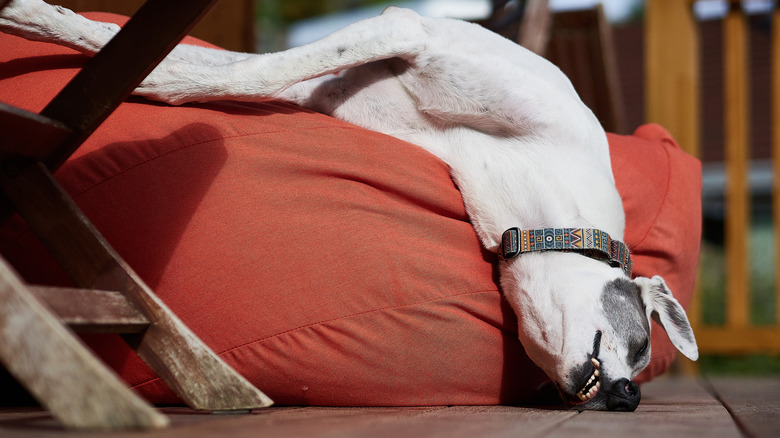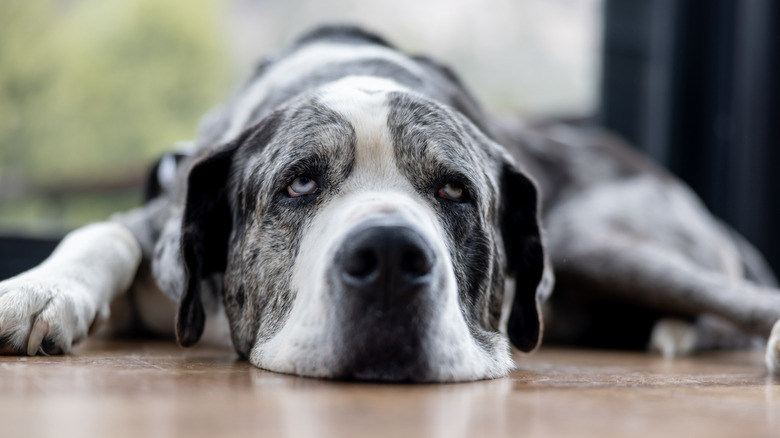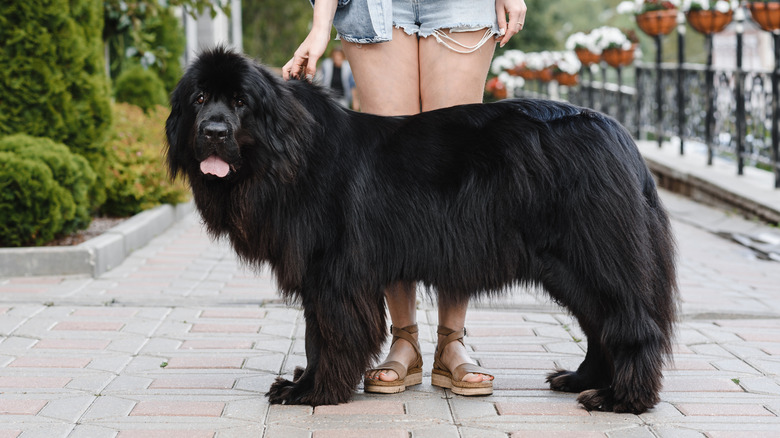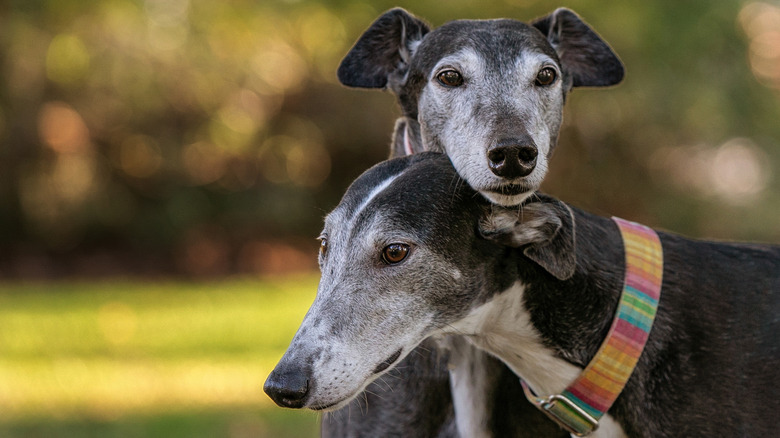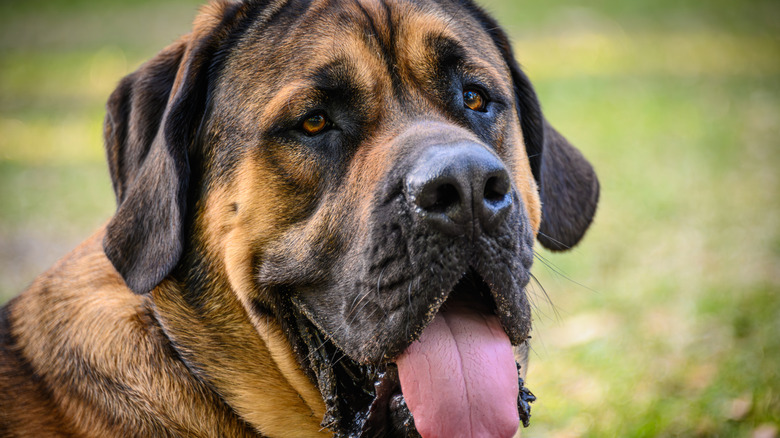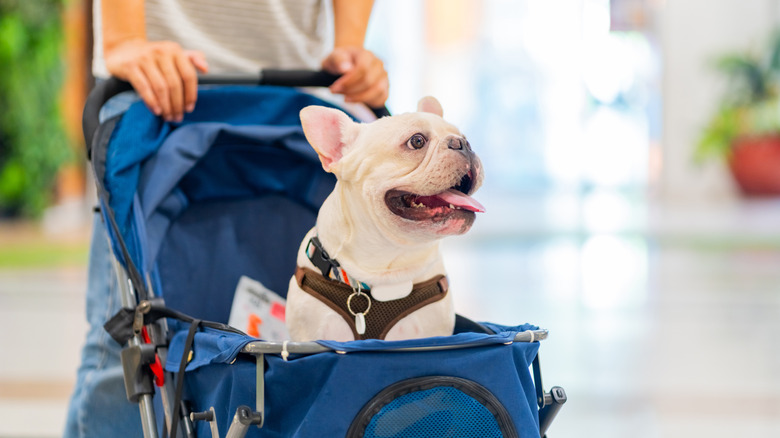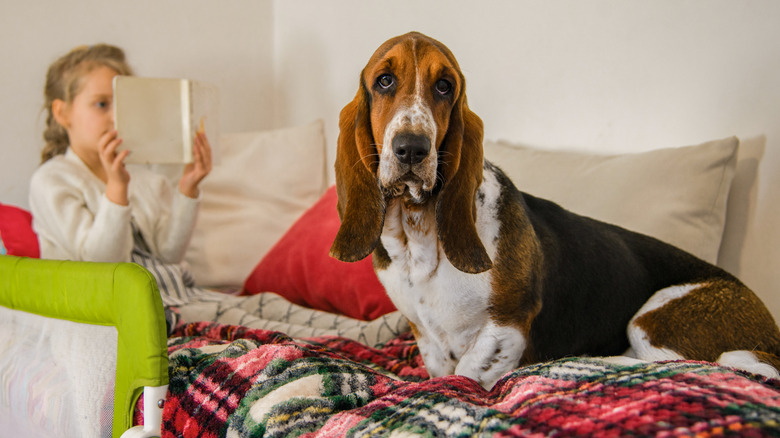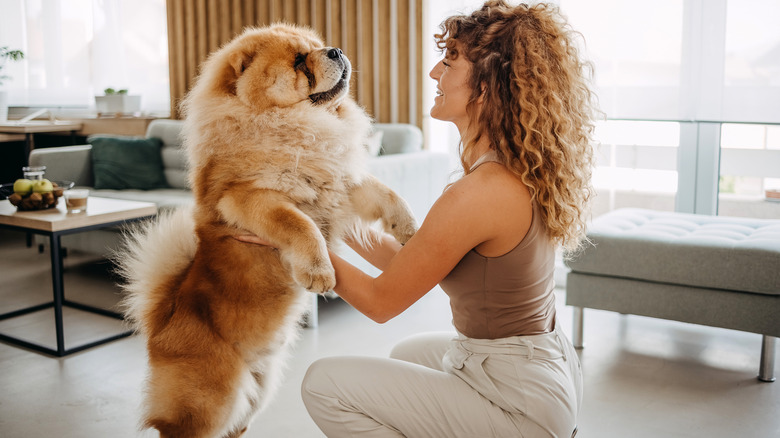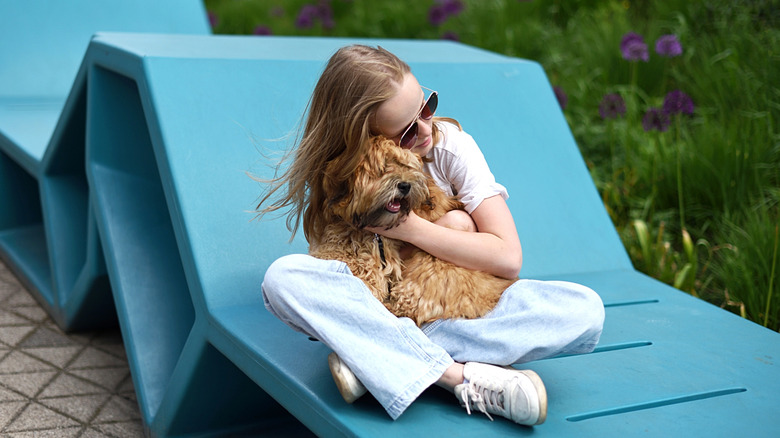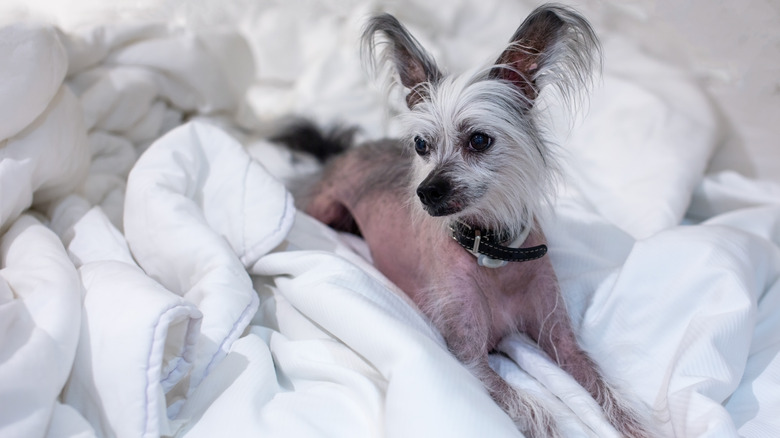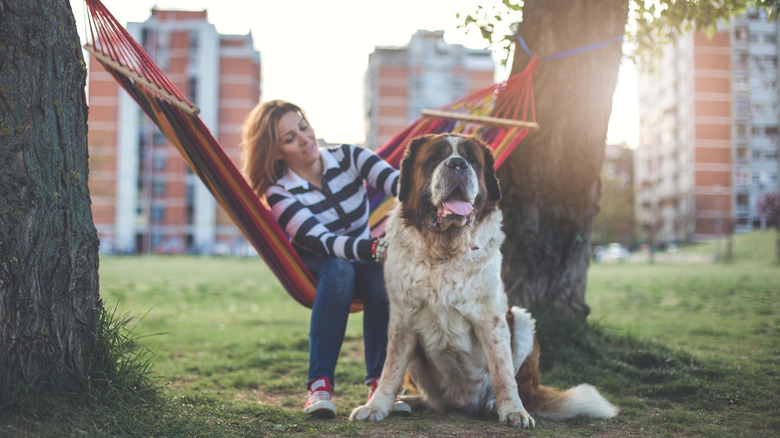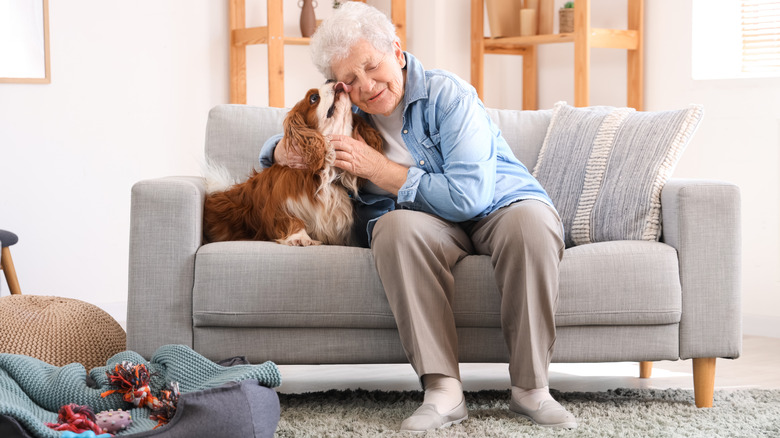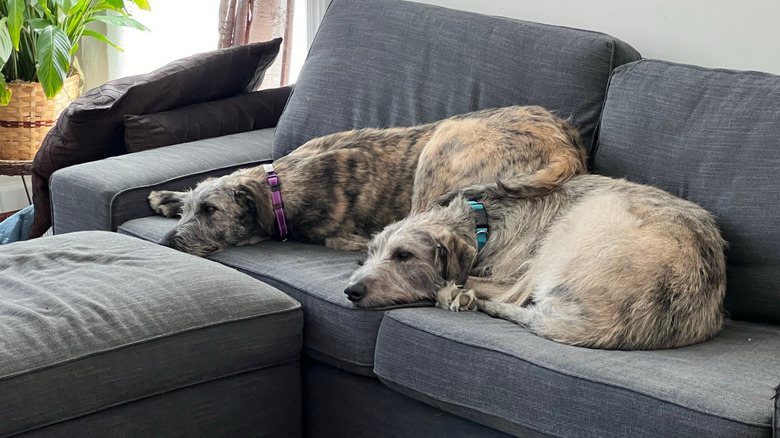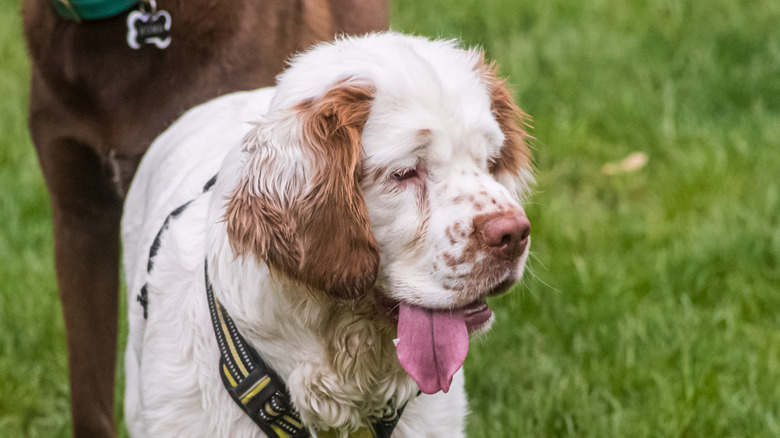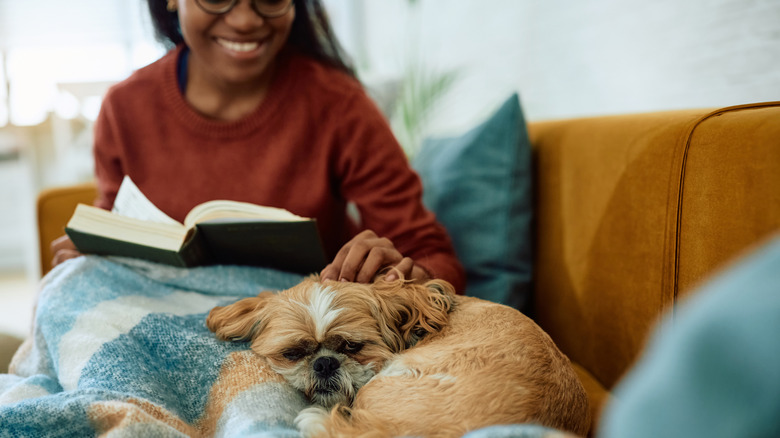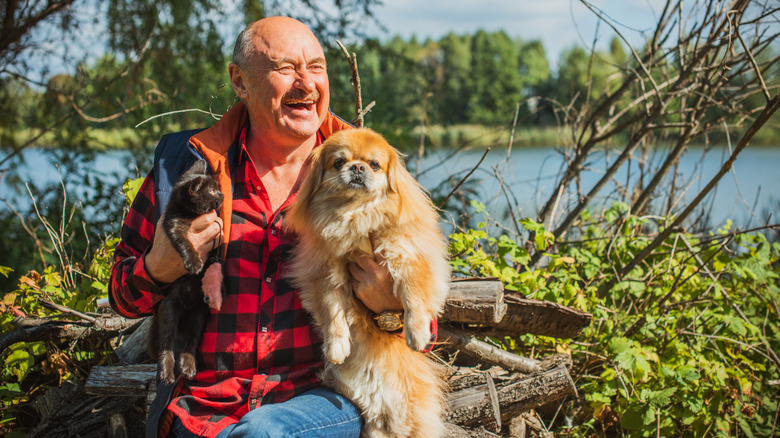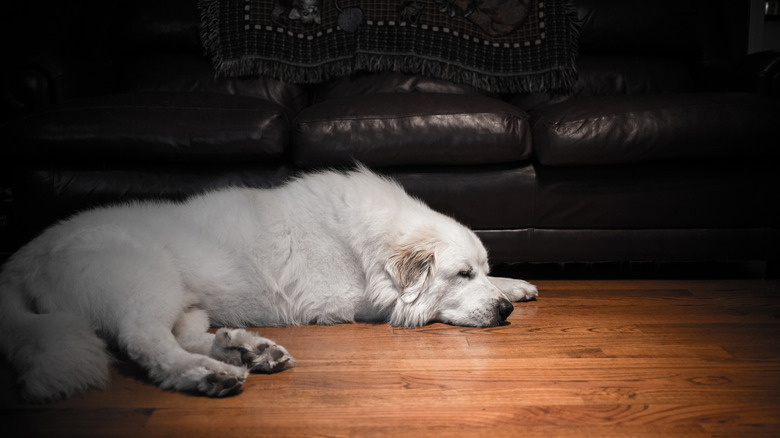16 Lazy, Low-Energy Dog Breeds That Make The Best Couch Potatoes
Most dogs love a good cuddle on the couch, but some breeds are practically willing to meld with the cushions. These dogs are true couch potatoes, creatures that find joy in snuggling and cozy naps rather than endless boisterous exercise. If you want a furry running partner or farm hand, a lazy, low-energy pup won't be much help. Less active dogs are perfect if you lead a more laid-back style or don't want to worry about satisfying intense exercise demands.
Low-energy dogs come in all sizes. There are peaceful giants, like Great Danes and Irish wolfhounds. There are also tiny breeds like the French bulldog that seem spirited but lack the stamina for serious exercise. Size doesn't matter as much when you get a lazy dog; whether it weighs ten pounds or 180 pounds, the serene pooch will want to curl up on the warmest and most comfortable spot in your home.
Life with Great Danes means sharing your couch
With its long legs and muscular body, the hulking Great Dane looks like an athletic powerhouse. However, the breed has strayed from its wild boar hunting roots and is now known for its gentle and calm demeanor. A Great Dane still has the strength for vigorous work and will happily go on a long hike or run; it's what these dogs do when they're not exercising that earns them a spot on this list.
After their daily bout of exercise, many Great Danes are perfectly content to curl up on the couch. They can easily spend most of the day lounging and hanging out with their humans. A Great Dane can be an ideal companion if you're ready to handle a dog that can weigh up to 175 pounds. You'll just need to provide plenty of space and be careful of your giant pup knocking things over.
Newfoundlands love a lazy day in
Another large breed with a loving disposition, the Newfoundland is an adorable snuggle buddy. It has a calm nature and can spend most of its time sitting around the house without getting bored. The average Newfoundland dog typically needs about 30 to 60 minutes of exercise per day. The exercise can be pretty intense, too, as Newfoundlands were bred to be hard workers and are notably strong. Those hard-working instincts shine in moments of activity but seemingly disappear when the work is done.
A pet parent posting on Reddit's r/Newfoundlander says that their Newfie "was very easy to train at puppy school, and is a big couch potato..." Another shares that after their pup Nova turned three years old, he "really didn't have much more than a 45 minute walk in him." Like most dogs, Newfoundlands tend to be more energetic when they're young puppies.
Greyhounds are lazy housemates
When racing, a greyhound has the elegance and speed of a born athlete. However, unlike top-tier human runners, greyhounds don't need to put in hours of work every day to maintain their speed. An adult greyhound is usually satisfied with a daily 30 to 45-minute walk and the occasional sprint. Greyhound owners often comment on their dogs' lazy habits on Reddit's r/Greyhounds. One owner says that one of their greyhound "doesn't even move for about 22 hours a day."
The greyhound's low-energy nature makes them well-suited for calm environments. They need to have some sort of crate or sleeping spot, but they don't need as much space as their up-to-70-pound frame might suggest. Greyhounds can be happy apartment dogs as long as they get some time outside. Another greyhound owner posting on r/Greyhounds admits that they fenced in a ¼ acre yard for their pups, but they "go out for 4 minutes in the morning, and then BEG to come in and sleep on the couch."
Mastiff are gentle homebodies
The mastiff is an ancient breed with fierce and heroic roots, so popular that Shakespeare wrote of the breed's "unmatchable courage" in "Henry V." Mastiffs were hunters, war dogs, and home protectors. Over time, they were bred to be sweeter, and their true cuddlebug nature emerged. Mastiffs can weigh up to 230 pounds and are lumbering forces of nature when playing, but their primary love is relaxing at home. Just like greyhounds, mastiffs can be quite happy in an apartment.
Mastiffs often love women and children, making them great family pets. They're also a good match for people who want a slow-paced walking companion rather than a jogging partner. Mastiffs can sprint if they're in good shape, but they can't handle long-distance runs. They don't have the stamina. The breed's low exercise needs mean they can stay healthy with just a 30-minute daily walk and some play time.
French bulldogs might snore throughout the afternoon
Flat-faced and big-eared, the French bulldog is a tiny sweetheart. Too much exercise can actually harm them as they're prone to having breathing problems and can overheat easily. A short walk is enough to tire out these pooches. Instead, they prefer to spend their energy on being the most adorable creatures in the room. French bulldogs are beloved because they ooze affection and warmth. They love making friends and can have a joyous life with almost any caring family. This breed has no problem hanging out with children, seniors, and other animals.
French bulldogs are big cuddlers and often don't need anything more than a warm lap to feel comfortable. A member of Facebook's French Bulldog Club Of South Australia Inc. says that while her 3-year-old pup gets the occasional bout of zoomies, she's "content to sleep on your lap most of the day and all night she's out cold." That's normal for this breed.
Basset hounds adore gentle snuggling
Basset hounds have squat little legs and eager personalities. They were bred to be devoted scent hounds, so they can be athletic. They'll never exhibit the loping grace of long-legged breeds like the greyhound, but they have enough stamina to remain on the hunt. However, when there's no prey in sight, Basset hounds prefer to lounge. They can be healthy and content with 20 to 30 minutes of walking per day. The breed has been referred to as the "armchair clown" because they're so lazy and lovable.
You might fall in love with Basset hounds if you want a low-energy dog that isn't over-the-top with its affections. This breed loves its people, yet it remains somewhat independent and aloof. This isn't a dog that wants to glue itself to your side. Basset hounds are also known for being slightly stubborn. They're trainable, but you may have to work hard to get them to listen at first.
Chow chows are proud loungers
Chow chows have the strength to hunt game and pull heavy carts, but their natural instincts are fairly lazy. They'll jump up for an hour or so of exercise, then spend the rest of the day as quiet homebodies. Chow chows do not crave a high amount of physical activity in their day, and what they do engage in needs to be carefully considered. Their gloriously thick coat makes being in the heat a real struggle. Pet parents also should avoid exposing their chows to high-impact exercise or roughhousing.
Having low energy makes some dogs more docile, but the regal chow chow wants to be the lord or lady of the home. This breed is stubborn, independent, and ready to defend its domain. That loyal spirit is incredibly endearing if you socialize your dog to accept friendly strangers. Socialization is even more important for chow chows that will be around small children and dogs.
Haveneses are happier in your arms
You might be surprised to see the Havenese on this list. The silky-haired charmer sometimes overflows with energy. However, even the wildest bout of excitement often ends quickly with this breed. The Havanese's tiny stature means it often tires easily, and overexercising can be dangerous. A few bouts of zoomies or a bit of rambunctious play can exhaust them. A pet parent who's part of the popular Havanese Forum says that after their 18-month-old Havanese named Churro gets 30 to 45 minutes of exercise, he's "happy lounging around."
Havaneses don't need hours of exercise. However, they'd eagerly accept hours of affection. They're lapdogs who want to be around their people all day. Havaneses are generous with their love and can lavish affection on everyone around them. They're irresistibly sweet and goofy. These dogs are also very adaptable, in part because their exercise requirements are so easy to satisfy. They can thrive whether they live in a quiet apartment or a busy family home.
Naps are part of everyday life for Chinese crested dogs
Just like the Havanese, the Chinese crested earns its low-energy status because it's tiny enough to be satisfied with a short walk. You can live a sedentary lifestyle and still keep your Chinese crested in good shape. What these dogs really desire is to be with their humans. They're quite cheerful and fun and do best in households where they can soak up tons of attention. This is not the right dog for people who prefer dignified and independent pets.
Chinese crested dogs are ultra lovey-dovey with family, but they can be shy around new people and animals. Small, playful children may pose a problem, too. Chinese crested dogs are fragile and can get hurt by an unwitting child if the surrounding adults aren't paying attention. Still, the breed's low energy needs and appealing disposition make it a good family pet.
Saint Bernards live to relax
Saint Bernards exemplify canine strength and beauty. They're hard workers that have historically been employed as rescue dogs in the Alps. However, if you're not training your dog to scour the mountaintops, it doesn't need much exercise. The Saint Bernard's impressive bulk can be maintained with as little as 30 minutes of daily activity. This breed has a patient and protective nature, so it's fine sitting around the house, keeping an eye on things.
Many Saint Bernards are enthralled by children, so they can be incredible family dogs. However, they can weigh up to 180 pounds, so there's a chance that little kids and those with mobility challenges can get knocked over. Saint Bernards are calm enough to live in an apartment if there's room for them to move around comfortably. They're low-energy dogs most of the time, so they don't need to sprint across the living room. They need to be able to move freely, lie down comfortably, and play.
Cavalier King Charles spaniels will match your pace
A happy cavalier King Charles spaniel adapts to your habits. Are you a devoted hiker who's always looking for new trails? A cavalier King Charles spaniel can be your partner. Are you a remote office worker who mostly relaxes at home? This breed enjoys that routine, as well. The key is spending time with you. Cavaliers are devoted companions that long to be with their people.
If you want to have lots of lazy days with your pooch, make sure you squeeze in some exercise. Cavalier King Charles spaniels are so agreeable that they may not push hard for energetic play or time outside. They need about 40 minutes of movement per day, and it's fine to break it up into multiple sessions. You might go for a short walk in the morning, toss a ball around the living room after lunch, and provide a treat puzzle in a the evening.
Irish wolfhounds can practically live on the couch
Lovable Irish wolfhounds often relish lazy moments at home. They naturally have a low to moderate energy level and have no problem turning into couch potatoes. Their health is best if you stick with a daily walk, however. A fit Irish wolfhound can typically handle at least an hour of exercise. They're athletic enough to triumph if you're interested in dog sports. They measure up to 32 inches tall at the shoulder and can weigh 120 pounds.
Irish wolfhounds look tough because of their tall, muscular frame. Yet, if you tried to use one of these low-energy pups as a guard dog, you'd quickly learn that the breed is far too gentle and friendly for such suspicious work. They're imposing in appearance alone. A member of Facebook's Irish Wolfhound Lovers group notes that this breed is "more likely to greet strangers with a wag than to protect you."
Clumber spaniels exude a calm energy
Bred to be a hunter, the Clumber spaniel is still a powerful and agile canine, but it doesn't need to follow a heavy exercise regime. A Clumber spaniel can curl up at your feet for hours while you work, or it can claim a comfortable spot on the couch. Clumber spaniels are low-energy pups that accept a slower pace in life. An owner on Reddit's r/Clumber board says that their dad used to call their Clumber spaniel a "floor ornament."
While this breed often indulges its lazy side, its exercise sessions are just as important. The Clumber spaniel might be the breed for you if you want a calm dog that's ready for the occasional run and extended play session. Quiet Clumber spaniels can appear like completely different dogs when they're running or romping outside. A remnant of their hunting past makes them love retrieving things. Instead of game birds and small animals, they can go after balls and frisbees instead.
Shih tzus love to sleep
The shih tzu once entertained Chinese emperors. Breeders picked the cutest and most sociable dogs and presented them as gifts. Today's shih tzus have evolved into loyal lap dogs that are prized for their friendliness. They were never hunters or working dogs, so they don't have an innate sense of athleticism. Shih tzus are tiny pups that revel in long cuddling sessions. They also like to nap. An adult shih tzu can sleep 16 hours a day.
Most shih tzus require minimal exercise, making them great couch companions. However, their energy level is rated at moderate. The discrepancy exists because shih tzus can work off their energy at home. A short daily walk is all they need if you commit to regular play as well. If you're busy, shih tzus can play with anyone in the house. They're exceedingly friendly and can get along with most creatures.
Pekingeses take lounging seriously
Pekingeses were bred to be companions, and they know their duty. They need about 30 to 60 minutes of exercise and can lounge the rest of the day. They're adoring creatures, but they're not quite gushy lap dogs. Pekingeses have an independent streak and may be impatient around children. The dogs make reasonable home alarm systems because they mistrust strangers and will alert you if someone invades your property, but they're too tiny to threaten anyone physically.
Most Pekingeses have mellow spirits perfect for calm and quiet environments. They like to nap and rest rather than be highly active. They're so content with a low-energy lifestyle that they can easily become overweight. You can prevent obesity in your Pekingese by making sure they get daily exercise. Walks are always appreciated, but romps around the house can be enough. Pekingese do not need much space and can live well in apartments.
Great Pyrenees are calm and watchful
Don't look to the Great Pyrenees if you want to see an active and highly energetic dog. This breed is prized for its quiet and sedate nature. At home, they're content to settle into their role as dedicated guardians. You can keep them in shape with regular moderate walks. Great Pyrenees dogs are impressively strong, but their strength is not for show. They were used to guard livestock and typically saved their might for grapples with wolves and bears.
Great Pyrenees dogs are lovely with family, but are too vigilant to be instant friends with strange people and dogs. Training can be difficult because of the breed's famous independence and need for personal space. Great Pyrenees dogs want to please you, yet they want to do it in their own way. Despite this, you can achieve great progress in their training if you're committed. The Great Pyrenees often makes a wonderful show dog and can excel in dog sports.
